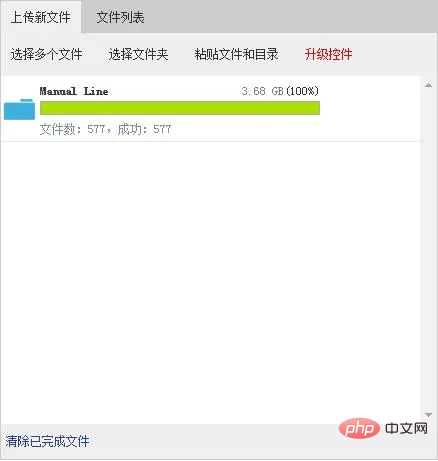How to implement multi-part file upload in PHP
Jan 17, 2020 pm 05:35 PM
PHP uses the super global variable array $_FILES to record file upload related information.
1.file_uploads=on/off
Whether it is allowed to upload files via http
2.max_execution_time=30
The maximum script execution time is allowed. If this time is exceeded, an error will be reported.
3.memory_limit=50M
Set the script to be allocated The maximum amount of memory to prevent runaway scripts from occupying too much memory. This directive can only be set at compile time.
--It only takes effect when the enable-memory-limit flag is set
4.upload_max_filesize=20M
The maximum size of files allowed to be uploaded, this The command must be smaller than post_max_size
5.upload_tmp_dir
Temporary storage directory for uploaded files
6.post_max_size=30M
Allow the post mode to accept the maximum size
$_FILES['myFile']['name'] The original name of the client's last file.
$_FILES['myFile']['type'] The MIME type of the file, which requires the browser to provide support for this information, such as "image/gif".
$_FILES['myFile']['size'] The size of the uploaded file, in bytes.
$_FILES['myFile']['tmp_name'] The temporary file name stored on the server after the file is uploaded, usually the system default. It can be specified in upload_tmp_dir in php.ini, but setting it with the putenv() function has no effect.
$_FILES['myFile']['error'] Status code related to the file upload. ['error'] was added in PHP 4.2.0. The following is its description: (They became constants after PHP3.0)
UPLOAD_ERR_OK
Value: 0; No error occurred and the file was uploaded successfully.
UPLOAD_ERR_INI_SIZE
Value: 1; The uploaded file exceeds the value limited by the upload_max_filesize option in php.ini.
UPLOAD_ERR_FORM_SIZE
Value: 2; The size of the uploaded file exceeds the value specified by the MAX_FILE_SIZE option in the HTML form.
UPLOAD_ERR_PARTIAL
Value: 3; Only part of the file was uploaded.
UPLOAD_ERR_NO_FILE
Value: 4; No file was uploaded.
Value: 5; The uploaded file size is 0.
After the file is uploaded, it is stored in the temporary directory by default. At this time, you must delete it from the temporary directory or Move it somewhere else, or if it doesn't exist, it will be deleted.
That is, regardless of whether the upload is successful or not, the files in the temporary directory will definitely be deleted after the script is executed.
Attachment: How to modify the size limit of PHP upload files
1. General file upload, unless the file is very small. Like a 5M file, it will probably take more than a minute to upload.
But in php, the default maximum execution time of the page is 30 seconds. That is to say, if it exceeds 30 seconds, the script will stop executing.
This results in the failure to open For the situation of the web page, we can modify max_execution_time
Look for
max_execution_time
in php.ini. The default is 30 seconds. Change to
max_execution_time = 0
0 means no limit
2. Modify post_max_size to set the maximum size allowed for POST data. This setting also affects file uploads.
The default post_max_size of php is 2M. If the POST data size is larger than post_max_size, $_POST and $_FILES superglobals will be empty.
Find post_max_size. Change to
post_max_size = 150M
3. Many people will change the second step, but the maximum size when uploading files is still 8M.
Why? We also need to change a parameter upload_max_filesize to indicate the maximum size of the uploaded file.
Look for upload_max_filesize, the default is 8M and change it to
upload_max_filesize = 100M
In addition, it should be noted that post_max_size is better than upload_max_filesize.
Upload effect display :

PHP Chinese website has a large number of free PHP video tutorials, everyone is welcome to learn!
This article is reproduced from: https://www.jianshu.com/p/6460dc947209

Hot AI Tools

Undress AI Tool
Undress images for free

Undresser.AI Undress
AI-powered app for creating realistic nude photos

AI Clothes Remover
Online AI tool for removing clothes from photos.

Clothoff.io
AI clothes remover

Video Face Swap
Swap faces in any video effortlessly with our completely free AI face swap tool!

Hot Article

Hot Tools

Notepad++7.3.1
Easy-to-use and free code editor

SublimeText3 Chinese version
Chinese version, very easy to use

Zend Studio 13.0.1
Powerful PHP integrated development environment

Dreamweaver CS6
Visual web development tools

SublimeText3 Mac version
God-level code editing software (SublimeText3)

Hot Topics
 How to get the current session ID in PHP?
Jul 13, 2025 am 03:02 AM
How to get the current session ID in PHP?
Jul 13, 2025 am 03:02 AM
The method to get the current session ID in PHP is to use the session_id() function, but you must call session_start() to successfully obtain it. 1. Call session_start() to start the session; 2. Use session_id() to read the session ID and output a string similar to abc123def456ghi789; 3. If the return is empty, check whether session_start() is missing, whether the user accesses for the first time, or whether the session is destroyed; 4. The session ID can be used for logging, security verification and cross-request communication, but security needs to be paid attention to. Make sure that the session is correctly enabled and the ID can be obtained successfully.
 PHP get substring from a string
Jul 13, 2025 am 02:59 AM
PHP get substring from a string
Jul 13, 2025 am 02:59 AM
To extract substrings from PHP strings, you can use the substr() function, which is syntax substr(string$string,int$start,?int$length=null), and if the length is not specified, it will be intercepted to the end; when processing multi-byte characters such as Chinese, you should use the mb_substr() function to avoid garbled code; if you need to intercept the string according to a specific separator, you can use exploit() or combine strpos() and substr() to implement it, such as extracting file name extensions or domain names.
 How do you perform unit testing for php code?
Jul 13, 2025 am 02:54 AM
How do you perform unit testing for php code?
Jul 13, 2025 am 02:54 AM
UnittestinginPHPinvolvesverifyingindividualcodeunitslikefunctionsormethodstocatchbugsearlyandensurereliablerefactoring.1)SetupPHPUnitviaComposer,createatestdirectory,andconfigureautoloadandphpunit.xml.2)Writetestcasesfollowingthearrange-act-assertpat
 How to split a string into an array in PHP
Jul 13, 2025 am 02:59 AM
How to split a string into an array in PHP
Jul 13, 2025 am 02:59 AM
In PHP, the most common method is to split the string into an array using the exploit() function. This function divides the string into multiple parts through the specified delimiter and returns an array. The syntax is exploit(separator, string, limit), where separator is the separator, string is the original string, and limit is an optional parameter to control the maximum number of segments. For example $str="apple,banana,orange";$arr=explode(",",$str); The result is ["apple","bana
 JavaScript Data Types: Primitive vs Reference
Jul 13, 2025 am 02:43 AM
JavaScript Data Types: Primitive vs Reference
Jul 13, 2025 am 02:43 AM
JavaScript data types are divided into primitive types and reference types. Primitive types include string, number, boolean, null, undefined, and symbol. The values are immutable and copies are copied when assigning values, so they do not affect each other; reference types such as objects, arrays and functions store memory addresses, and variables pointing to the same object will affect each other. Typeof and instanceof can be used to determine types, but pay attention to the historical issues of typeofnull. Understanding these two types of differences can help write more stable and reliable code.
 Using std::chrono in C
Jul 15, 2025 am 01:30 AM
Using std::chrono in C
Jul 15, 2025 am 01:30 AM
std::chrono is used in C to process time, including obtaining the current time, measuring execution time, operation time point and duration, and formatting analysis time. 1. Use std::chrono::system_clock::now() to obtain the current time, which can be converted into a readable string, but the system clock may not be monotonous; 2. Use std::chrono::steady_clock to measure the execution time to ensure monotony, and convert it into milliseconds, seconds and other units through duration_cast; 3. Time point (time_point) and duration (duration) can be interoperable, but attention should be paid to unit compatibility and clock epoch (epoch)
 How to pass a session variable to another page in PHP?
Jul 13, 2025 am 02:39 AM
How to pass a session variable to another page in PHP?
Jul 13, 2025 am 02:39 AM
In PHP, to pass a session variable to another page, the key is to start the session correctly and use the same $_SESSION key name. 1. Before using session variables for each page, it must be called session_start() and placed in the front of the script; 2. Set session variables such as $_SESSION['username']='JohnDoe' on the first page; 3. After calling session_start() on another page, access the variables through the same key name; 4. Make sure that session_start() is called on each page, avoid outputting content in advance, and check that the session storage path on the server is writable; 5. Use ses
 How does PHP handle Environment Variables?
Jul 14, 2025 am 03:01 AM
How does PHP handle Environment Variables?
Jul 14, 2025 am 03:01 AM
ToaccessenvironmentvariablesinPHP,usegetenv()orthe$_ENVsuperglobal.1.getenv('VAR_NAME')retrievesaspecificvariable.2.$_ENV['VAR_NAME']accessesvariablesifvariables_orderinphp.iniincludes"E".SetvariablesviaCLIwithVAR=valuephpscript.php,inApach





